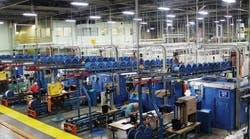“The key to success is not the guy in the corner office,” Paul Furtado emphasizes, “it’s the people out on the floor. They get it. They understand that in order to survive, they have to change. They have to be flexible. Leadership is what gives passion to people to say, ‘We can get there.’”
As plant manager for General Cable’s Lawrenceburg, Ky., facility, Furtado is “the guy in the corner office,” but it is clear that his focus is on the 300 employees in the plant and the immediate destination is a sweeping change to an operator-led process control environment where employees “own and manage” the production process.
The Lawrenceburg facility produces two basic product lines. Telecom cables, the familiar thick cable seen on telephone poles and in underground installations, consist of from 9 to 4,200 pairs of copper wire. These complex products cover thousands of part numbers. For General Cable, this is a maintenance business. The growth at Lawrenceburg comes from datacom cables, such as the Cat 5 and Cat 6 twisted pair cables used for computer and electronic data transfer.
The leading edge of change at the plant is at the CAT 3 cell, a production cell for datacom cable where hourly associates manage all aspects of the operation. “This is a supervisor-less cell,” Furtado notes. “We have one person who is a value stream manager who checks in with them to see if they need anything and serves as a coach and mentor.”
At the cell, operator Mike Johnson describes how each of the five cell operators not only run the machines but are also responsible for a specific duty – production, safety, maintenance, quality and human resources. A large board in the cell tracks essential metrics as well as the operators’ progress on cross-training and action items. The cell operators have all undergone training designed to help them work as a self-directed team.
Why make the move to production cells? Furtado says it is essential to develop a structure where associates take responsibility for the day-to-day decisions in their work area and develop the flexibility to handle any job in the cell. Working as a team, he notes, the cell should see a 10% to 15% increase in throughput and utilize labor more efficiently.
Work on developing the second of what will eventually be six production cells is underway. “A year or two from now, this plant will be completely different than it is today,” says Furtado.
The Lawrenceburg plant sets direction for its continuous improvement efforts through a LeanSigma council – consisting of Furtado, his staff and blackbelts – that meets monthly. That group determines what issues need to be addressed, and reviews ongoing projects to assess progress and ensure the right resources are devoted to them.
During their first year at the plant, every employee takes an “Introduction to Lean” course. From there, employees are encouraged to become a Lean Technician, which involves five days of additional training and involvement in a kaizen or lean project. Lawrenceburg has 25 lean technicians, with eight more pending and another eight scheduled for 2012.
Furtado calls the production of wiring cables “hard-core manufacturing that takes good, strong people to run it.” And while he’s proud of the accomplishments at the plant, he is quick to point out, “What we're excited about is how much more this facility can improve on over time.”




